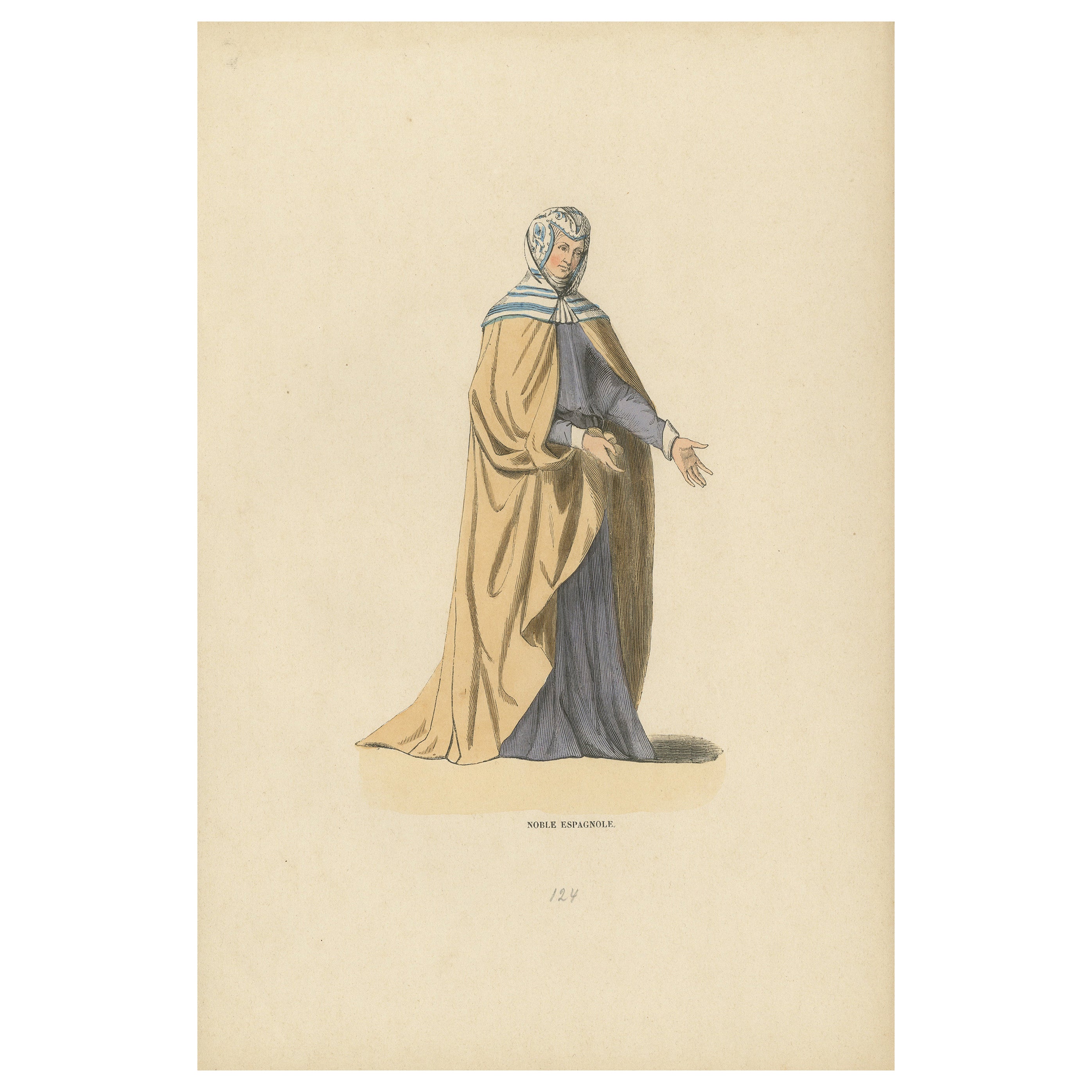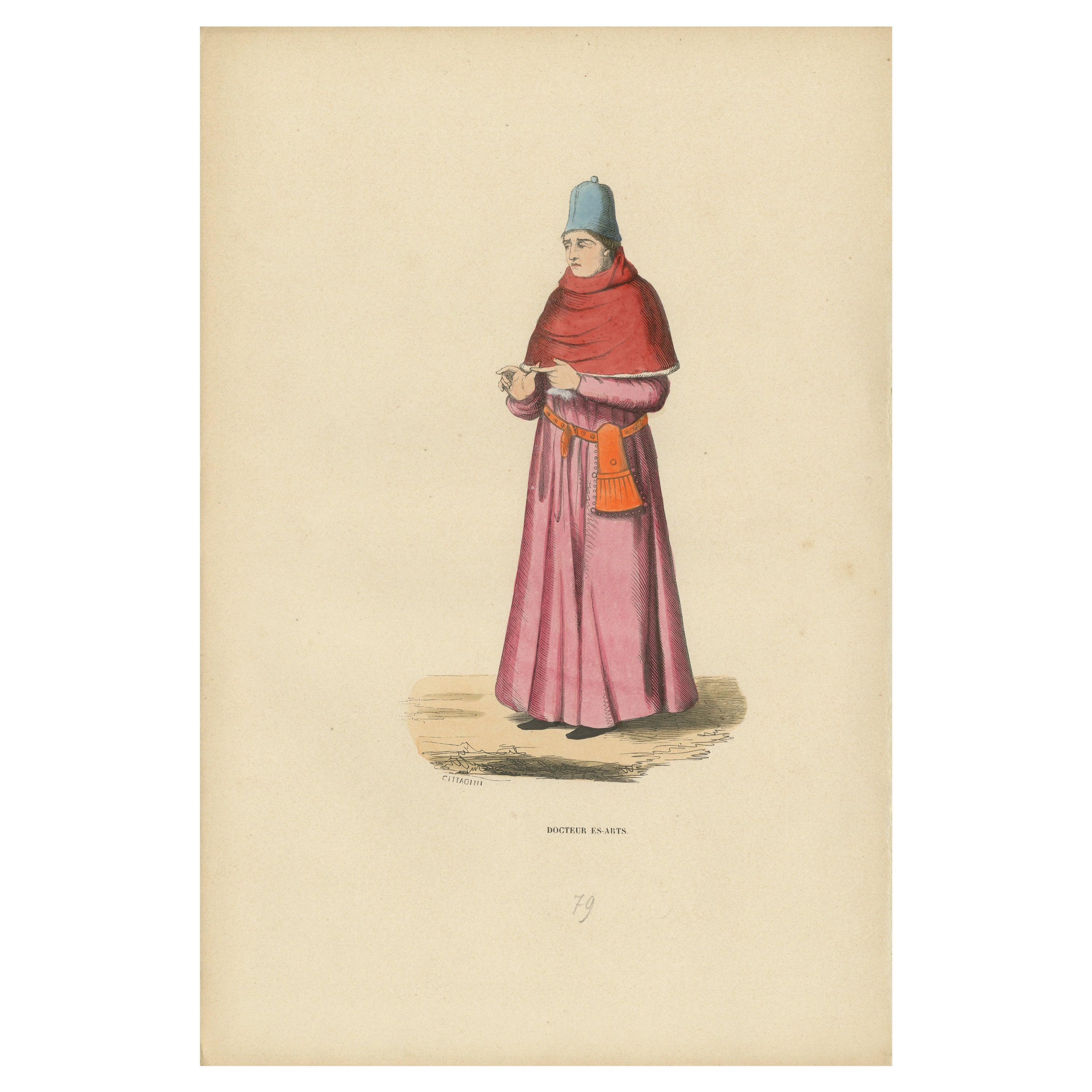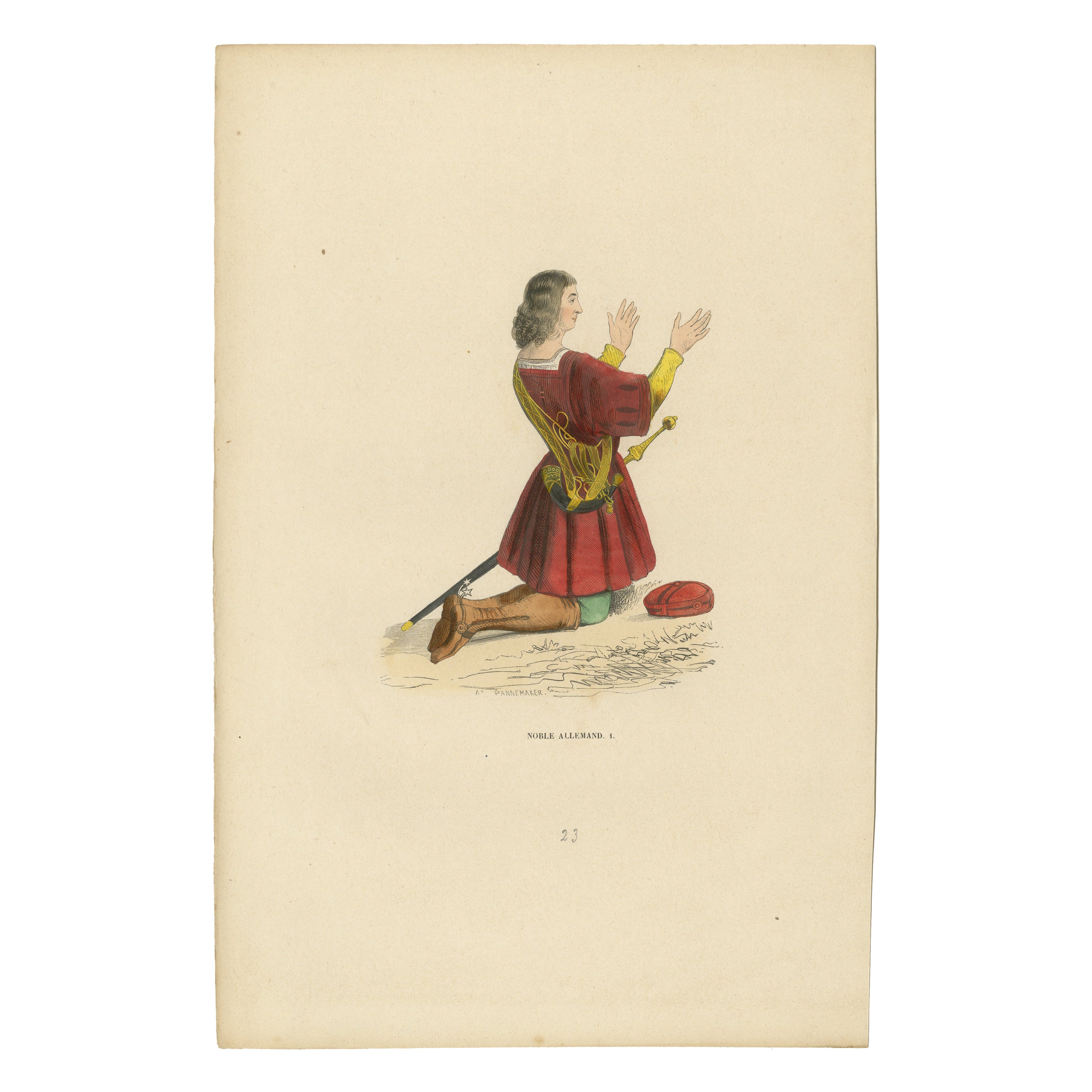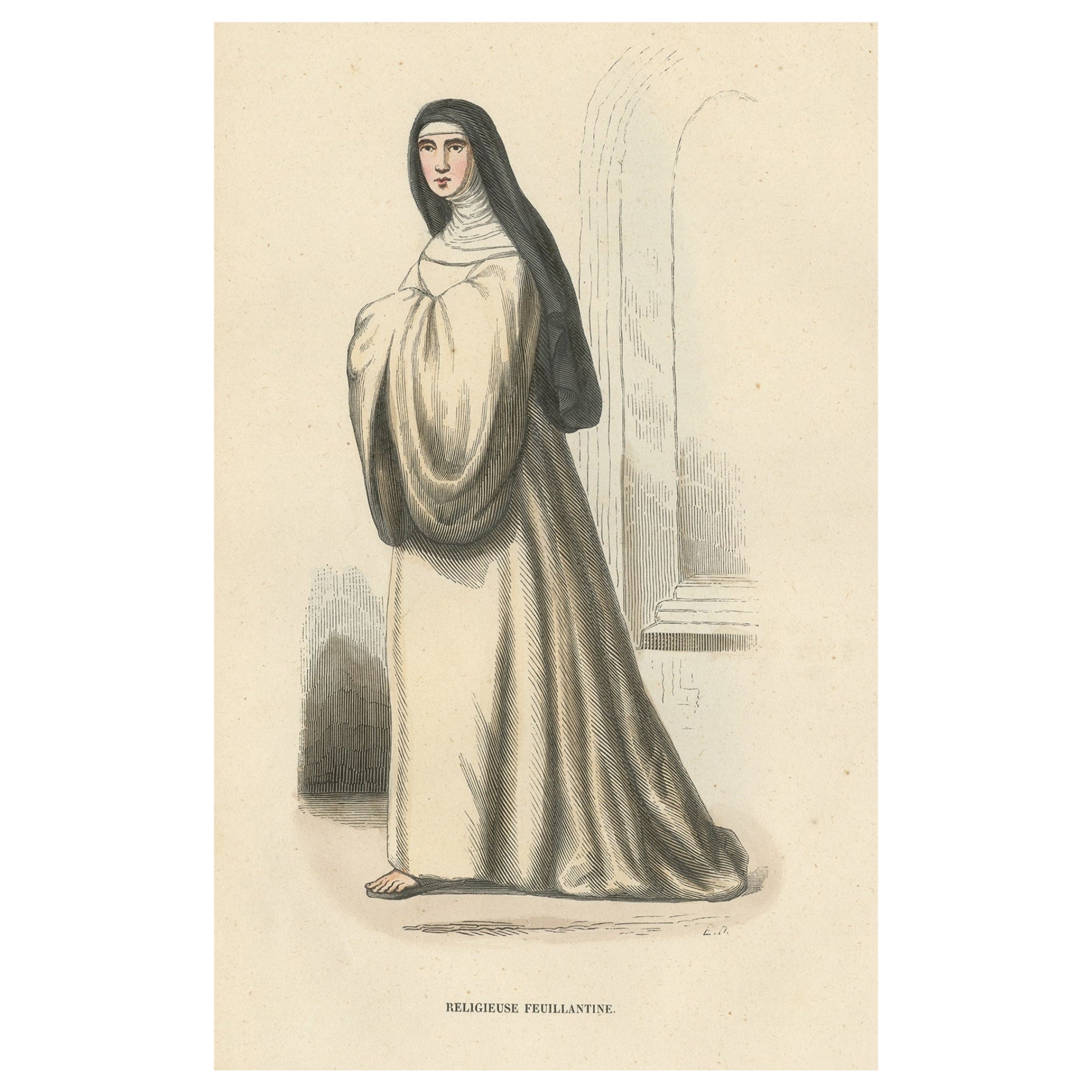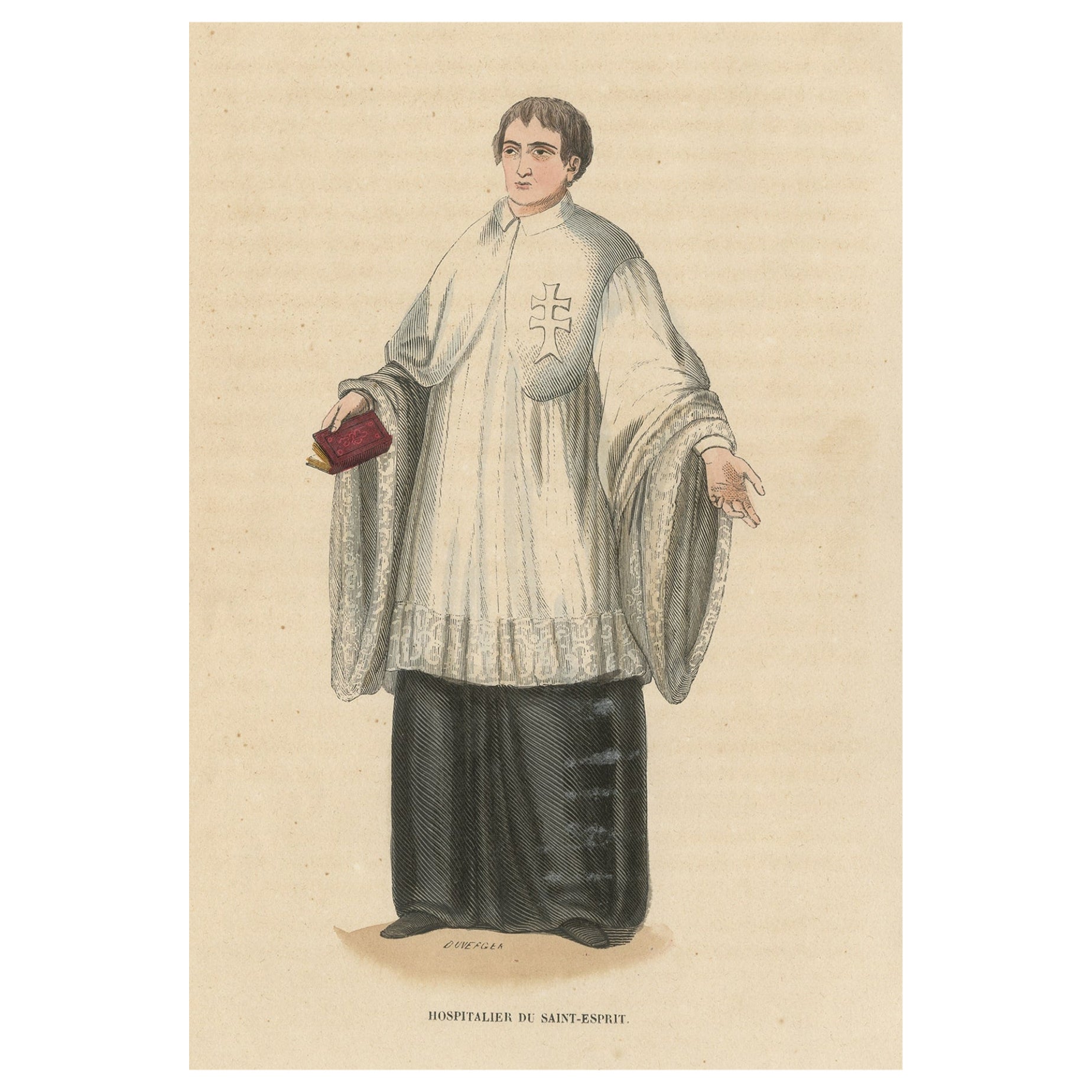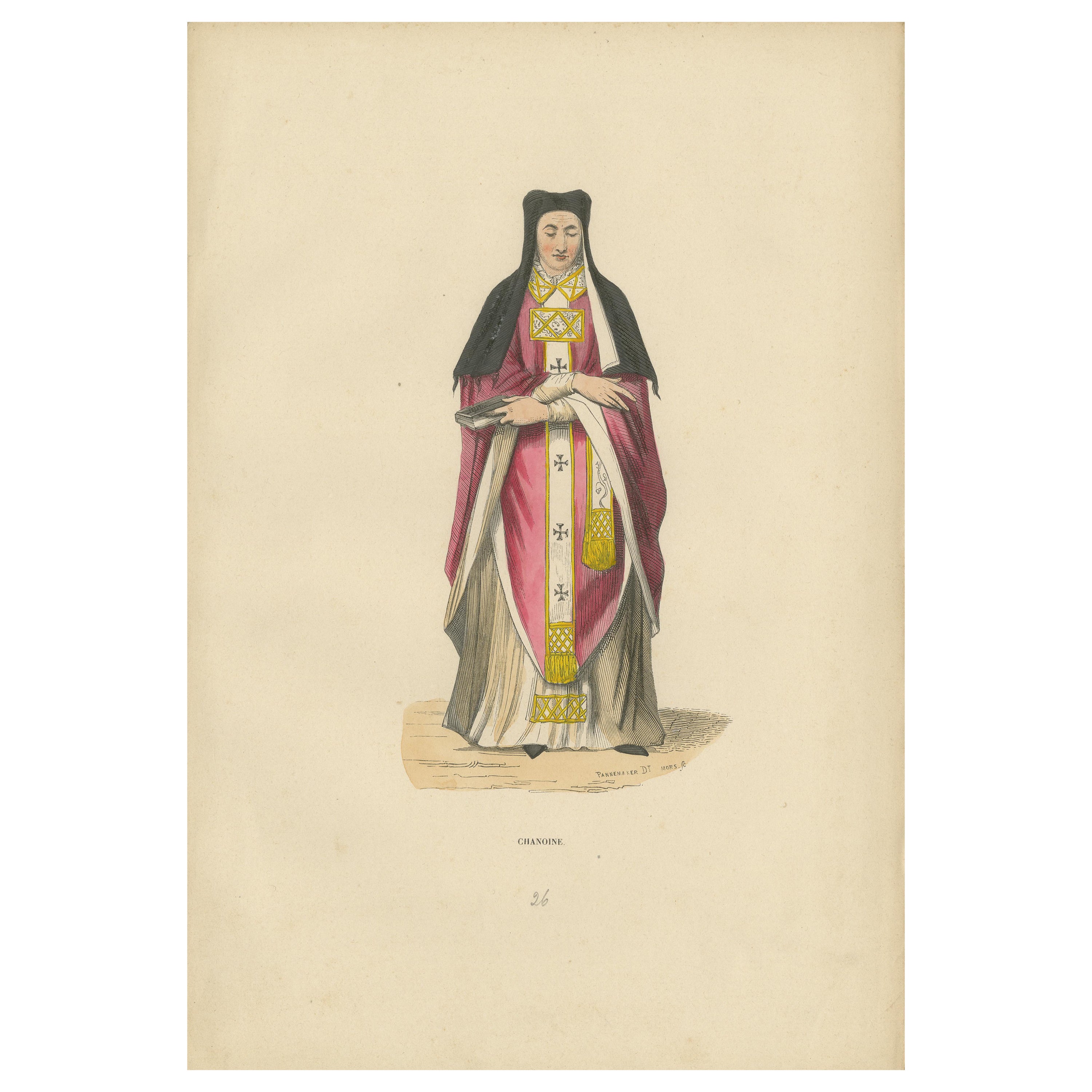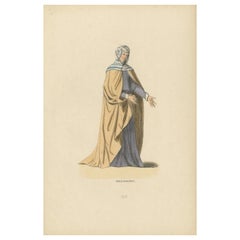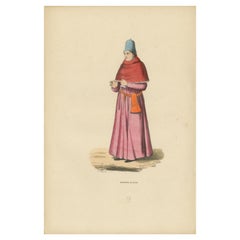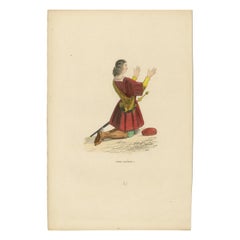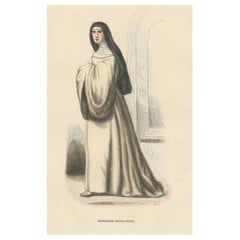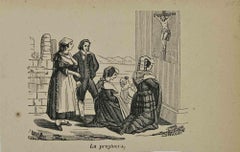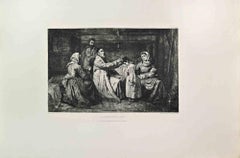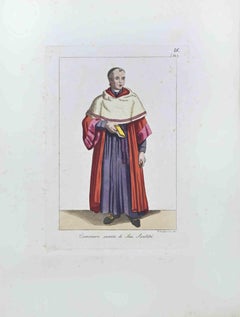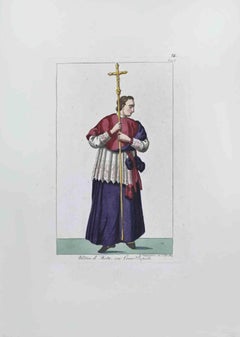Items Similar to Devout Reflection: A Medieval Bourgeoise in Prayer, 1847
Want more images or videos?
Request additional images or videos from the seller
1 of 6
Devout Reflection: A Medieval Bourgeoise in Prayer, 1847
$123.62
$154.5220% Off
£92.06
£115.0720% Off
€104
€13020% Off
CA$170.67
CA$213.3420% Off
A$189.21
A$236.5220% Off
CHF 99.44
CHF 124.3020% Off
MX$2,315.66
MX$2,894.5720% Off
NOK 1,241.89
NOK 1,552.3620% Off
SEK 1,165.64
SEK 1,457.0520% Off
DKK 791.82
DKK 989.7820% Off
About the Item
Title: "Devout Reflection: A Medieval Bourgeoise in Prayer"
Description: This print presents a serene image of a woman, labeled as a bourgeoise, engaged in an act of devotion. Her attire reflects a modest yet refined status, suitable for a woman of the middle class in medieval society.
She is clothed in a full-length robe or gown of a gentle hue, which falls softly to the ground, conveying a sense of simplicity and humility. The gown is cinched at the waist, creating a graceful silhouette that is both modest and becoming of her status.
Over her gown, she wears a mantle or cloak that drapes around her shoulders and flows down, with visible detailed edging that adds a subtle decorative element to her outfit. The cloak's texture is finely rendered, suggesting a quality fabric that denotes her respectable position in society.
Her head is covered with a wimple and veil, traditional head coverings for women of the time, which symbolize modesty and piety. The wimple frames her face, directing focus to her calm and contemplative expression.
Her hands are clasped in front of her chest, holding a string of beads, likely a rosary, which serves as a focal point for prayer and meditation. The beads provide a stark contrast against her pale attire, with their red color symbolizing passion and the suffering of Christ, common themes in devotional practice.
Her posture and the closed eyes indicate a moment of quiet introspection or prayer, reflecting the importance of personal faith and devotion in the lives of the medieval laity. The image captures a moment of spirituality and the inward focus of a woman finding solace and strength in her faith.
The colors have a nice glow over them. Historically, egg whites, known as glair, and sometimes egg yolk were indeed used in illumination and painting, particularly in manuscripts, to give colors a brighter appearance and to add a sheen or gloss to the work. This technique was quite common during the Middle Ages and into the Renaissance.
Egg whites can be applied as a varnish over pigments to enhance their brightness and to protect the colors. This application could make the colors appear more vivid and also add a slight glossy sheen to the surface of the image.
Egg yolk, on the other hand, was commonly used as a binding agent in paint. It forms the basis of tempera paint, a medium that was widely used before the advent of oil painting. Egg yolk helps to create a durable and long-lasting color that adheres well to various surfaces.
In the context of the print from 1847, it's less likely that egg whites or yolks were used directly on the print, as by that time, commercial printing processes would have been more advanced and less reliant on such manual methods. However, if this print is a representation of an earlier style or is meant to mimic the appearance of hand-painted manuscripts, the original artists might have employed techniques or materials that gave a similar effect to those achieved with egg-based binders and varnishes.
- Dimensions:Height: 10.63 in (27 cm)Width: 7.09 in (18 cm)Depth: 0 in (0.02 mm)
- Materials and Techniques:
- Period:
- Date of Manufacture:1847
- Condition:Good. Overal light toning and light soiling but the image itself clean and hand-colored almost 200 years ago and still in expliciet colors. Aged paper with typically warm, yellowish-brown hue, mostly around the edges. Study the image carefully.
- Seller Location:Langweer, NL
- Reference Number:Seller: BG-13635-511stDibs: LU3054337895002
About the Seller
5.0
Recognized Seller
These prestigious sellers are industry leaders and represent the highest echelon for item quality and design.
Platinum Seller
Premium sellers with a 4.7+ rating and 24-hour response times
Established in 2009
1stDibs seller since 2017
2,609 sales on 1stDibs
Typical response time: <1 hour
- ShippingRetrieving quote...Shipping from: Langweer, Netherlands
- Return Policy
Authenticity Guarantee
In the unlikely event there’s an issue with an item’s authenticity, contact us within 1 year for a full refund. DetailsMoney-Back Guarantee
If your item is not as described, is damaged in transit, or does not arrive, contact us within 7 days for a full refund. Details24-Hour Cancellation
You have a 24-hour grace period in which to reconsider your purchase, with no questions asked.Vetted Professional Sellers
Our world-class sellers must adhere to strict standards for service and quality, maintaining the integrity of our listings.Price-Match Guarantee
If you find that a seller listed the same item for a lower price elsewhere, we’ll match it.Trusted Global Delivery
Our best-in-class carrier network provides specialized shipping options worldwide, including custom delivery.More From This Seller
View AllDignified Poise of a Spanish Noblewoman in an Original Lithograph Published 1847
Located in Langweer, NL
Title: "Dignified Poise of a Spanish Noblewoman: A Lithographic Study from 'Costume du Moyen Âge'"
Description: This striking lithograph from the historic 1847 anthology "Costume du Moyen Âge" portrays a Spanish noblewoman in traditional attire, captured with an essence of nobility and refined grace. The noblewoman is depicted in a three-quarter stance, her gaze gently directed towards the viewer, which creates an intimate connection with the audience. Her dress is a harmony of practicality and elegance, characterized by a full-length, tan cloak that wraps around her figure, edged with a subtle blue stripe that adds a touch of color to the otherwise muted palette.
The noblewoman's headdress, a distinctive feature of her ensemble, is a beautifully patterned headscarf, its intricate design suggesting a status of wealth and sophistication. The scarf is secured around her head and beneath her chin, framing her face and highlighting her serene and composed expression. Beneath the cloak, glimpses of a dark undergarment can be seen, suggesting layers that were typical of the era's fashion.
Her right hand extends gracefully, perhaps in a gesture of communication or to display her ring, indicative of her marital status and her family's coat of arms. The lithograph demonstrates an exquisite attention to textile and pattern, which not only conveys the fashion of the period but also the cultural identity and social stature of the noblewoman.
As with other pieces in the collection, the background is deliberately left blank, focusing all attention on the subject and her costume. This lithographic work serves as both an artistic and historical document, offering insight into the lifestyle and status of noblewomen in medieval...
Category
Antique 1840s Prints
Materials
Paper
$133 Sale Price
20% Off
Scholar of the Arts: The Medieval Academic, 1847
Located in Langweer, NL
Title: "Scholar of the Arts: The Medieval Academic"
Description: This print illustrates a learned individual, likely a doctor of the arts or a scholar, from the medieval period. The...
Category
Antique 1840s Prints
Materials
Paper
$114 Sale Price
20% Off
The Noble's Plea: A German Aristocrat in Supplication, 1847
Located in Langweer, NL
The image depicts a figure labeled as "Noble Allemand," which means "German Noble." The nobleman is shown kneeling on one leg, with his hands raised in what could be a gesture of exc...
Category
Antique 1840s Prints
Materials
Paper
$123 Sale Price
20% Off
French Nun of the Order of Feuillantines, a Catholic Congregation, 1845
Located in Langweer, NL
Antique print titled 'Religieuse Feuillantine'.
Print of a Nun of the order of Feuillantines, Congregation of Our Lady of the Feuillants, Cistercian. This print originates from 'Histoire et Costumes des Ordres Religieux'.
The Feuillants were a Catholic congregation originating in the 1570s as a reform group within the Cistercians in its namesake Les Feuillants Abbey in France, which declared itself an independent order. In 1630 it separated into a French branch (the Congregation of Our Lady of the Feuillants) and an Italian branch...
Category
Antique 1840s Prints
Materials
Paper
$209 Sale Price
20% Off
Hospitaler of the Order of the Holy Ghost, Roman Catholic Order, 1845
Located in Langweer, NL
Antique print titled 'Hospitalier du Saint-Esprit'.
Print of a Hospitaler of the Order of the Holy Ghost, Hospitallers of the Holy Spirit, Roman Catholi...
Category
Antique 1840s Prints
Materials
Paper
$228 Sale Price
20% Off
In Solemn Duty: A Canon in Contemplation, Hand-Colored Lithograph, 1847
Located in Langweer, NL
The image portrays a figure labeled "Chanoine," which is French for "Canon," referring to a clergy member who is part of a cathedral or a collegiate chapter. The individual is depicted in ecclesiastical robes that reflect his status within the church hierarchy.
The canon is shown wearing a long, pink robe with a decorative stole over it, which is adorned with Christian symbols and patterns indicating his religious office. Over the robe, he wears a black mozzetta, a short cape that is typically worn by higher clergy in the Roman Catholic Church. He also has a white almuce, a fur-trimmed hood or shoulder cape worn by canons, draped over his left arm, and he is holding what appears to be a book of scripture or liturgy.
His head is adorned with a biretta, a square cap with three or four peaks...
Category
Antique 1840s Prints
Materials
Paper
$142 Sale Price
20% Off
You May Also Like
Uses and Customs - Prayer - Lithograph - 1862
Located in Roma, IT
Uses and Customs - Prayer is a lithograph on paper realized in 1862.
The artwork belongs to the Suite Uses and customs of all the peoples of the universe: " History of the governmen...
Category
1860s Modern Figurative Prints
Materials
Lithograph
La. Benediction de l'Aieul - Etching by Edouard Moyse - 1860s
Located in Roma, IT
La. Benediction de l'Aieul is a black and White etching realized by Edouard Moyse in the 1860s.
Titled in the lower.
Image size:23x31.
Very good impression with wide margins and ...
Category
1860s Modern Figurative Prints
Materials
Etching
"Cameriere Secreto di Sua Santità" - Etching by Giuseppe Capparoni - 1827
Located in Roma, IT
"Cameriere Secreto di Sua Santità" is an Artwork realized in 1827 by the Engraver, Giuseppe Capparoni (Rome 1800- 1879).
Etching hand colored on ivory paper. Signed on plate on the ...
Category
1820s Modern Portrait Prints
Materials
Etching
"Uditore di Rota con Croce Papale" - Etching by Giuseppe Capparoni - 1827
Located in Roma, IT
"Uditore di Rota con Croce Papale" is an Artwork realized in 1827 by the Engraver, Giuseppe Capparoni (Rome 1800- 1879).
Etching hand colored on ivory paper. Signed on plate and dat...
Category
1820s Modern Portrait Prints
Materials
Etching
The Holy Father - Etching - 19th Century
Located in Roma, IT
The Holy Father is an original etching hand-watercolored on paper, realized by an Anonymous italian artist in 19th Century.
With description on the lower in Italian.
In good condit...
Category
19th Century Modern Figurative Prints
Materials
Etching
The Canon - Etching by Giuseppe Capparoni - 1827
Located in Roma, IT
The Canon is an Artwork realized in 1827 by the Engraver, Giuseppe Capparoni (Rome 1800- 1879).
Etching hand colored on ivory paper. Signed on plate and dated on the right margin.
...
Category
1820s Modern Portrait Prints
Materials
Etching
More Ways To Browse
Medieval Head
Prayer Beads
Antique Prayer Beads
Manuscript Chest
Antique Rosary Beads
Antique Glass Powder Boxes
Antique Horse Wagon
Antique Hunting Accessories
Antique Hunting Pack
Antique Metal Rooster
Antique Metal Tea Pot
Antique Necessaire
Antique Pie Case
Antique Pill Box Gold
Antique Sake Set
Antique Silver Boxes Repousse
Antique Storm Glass
Antique Thimbles
